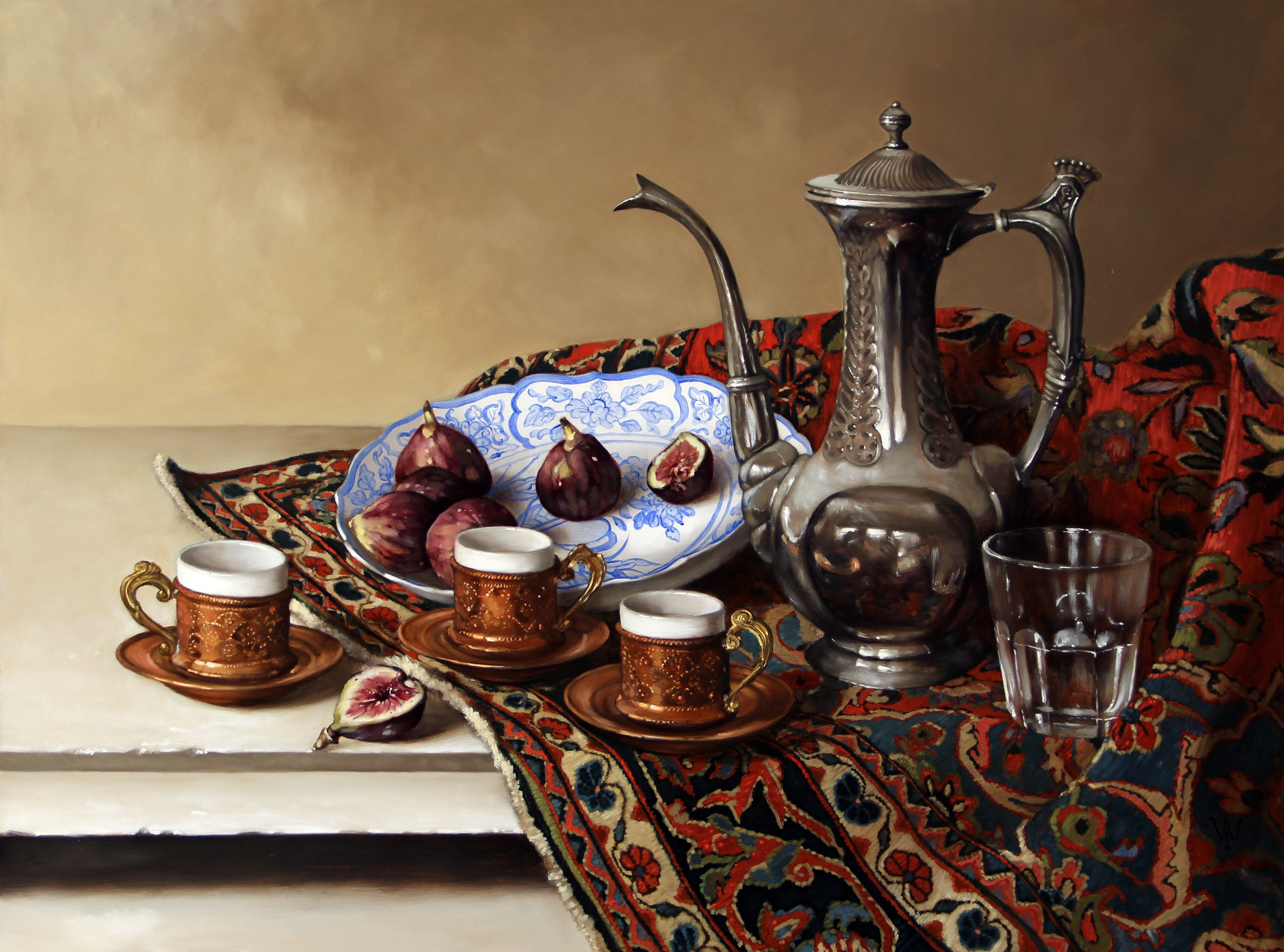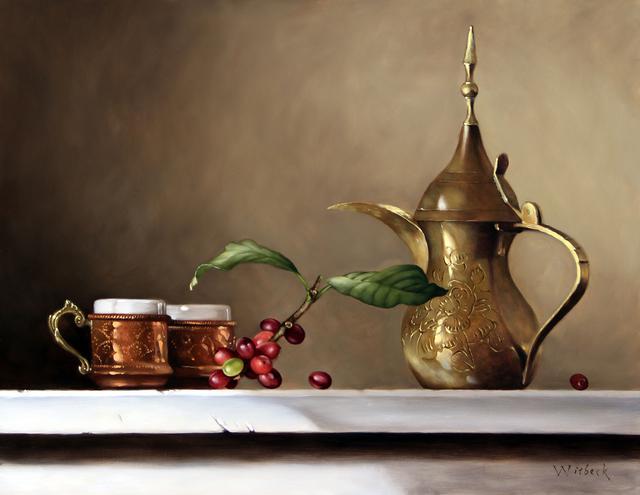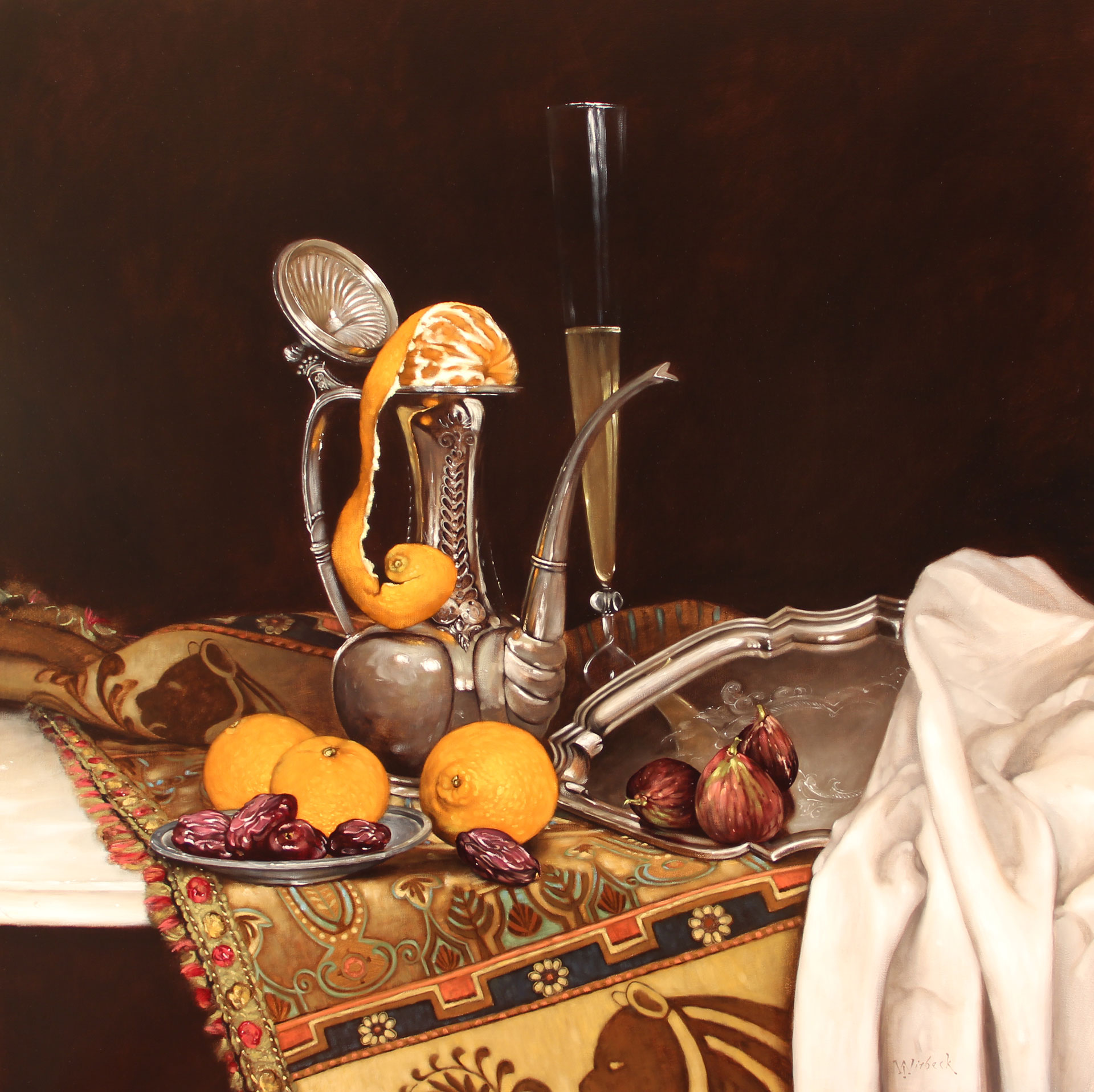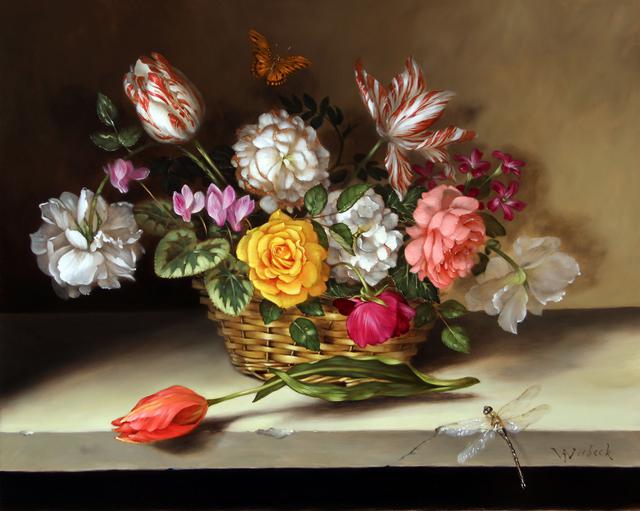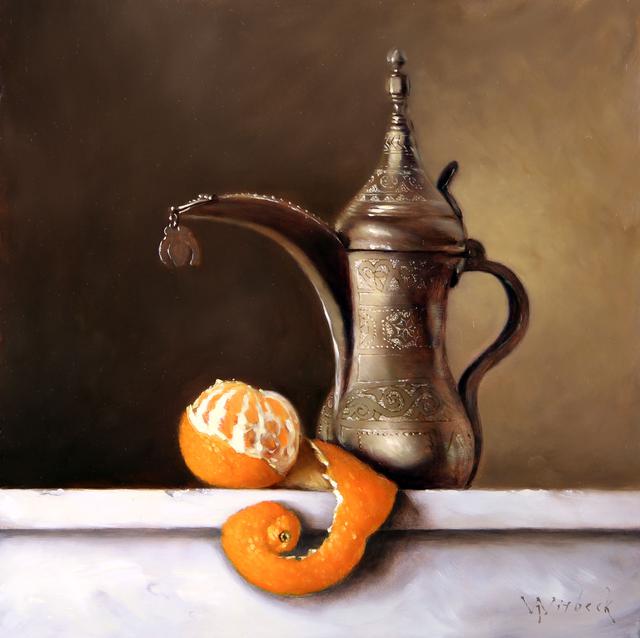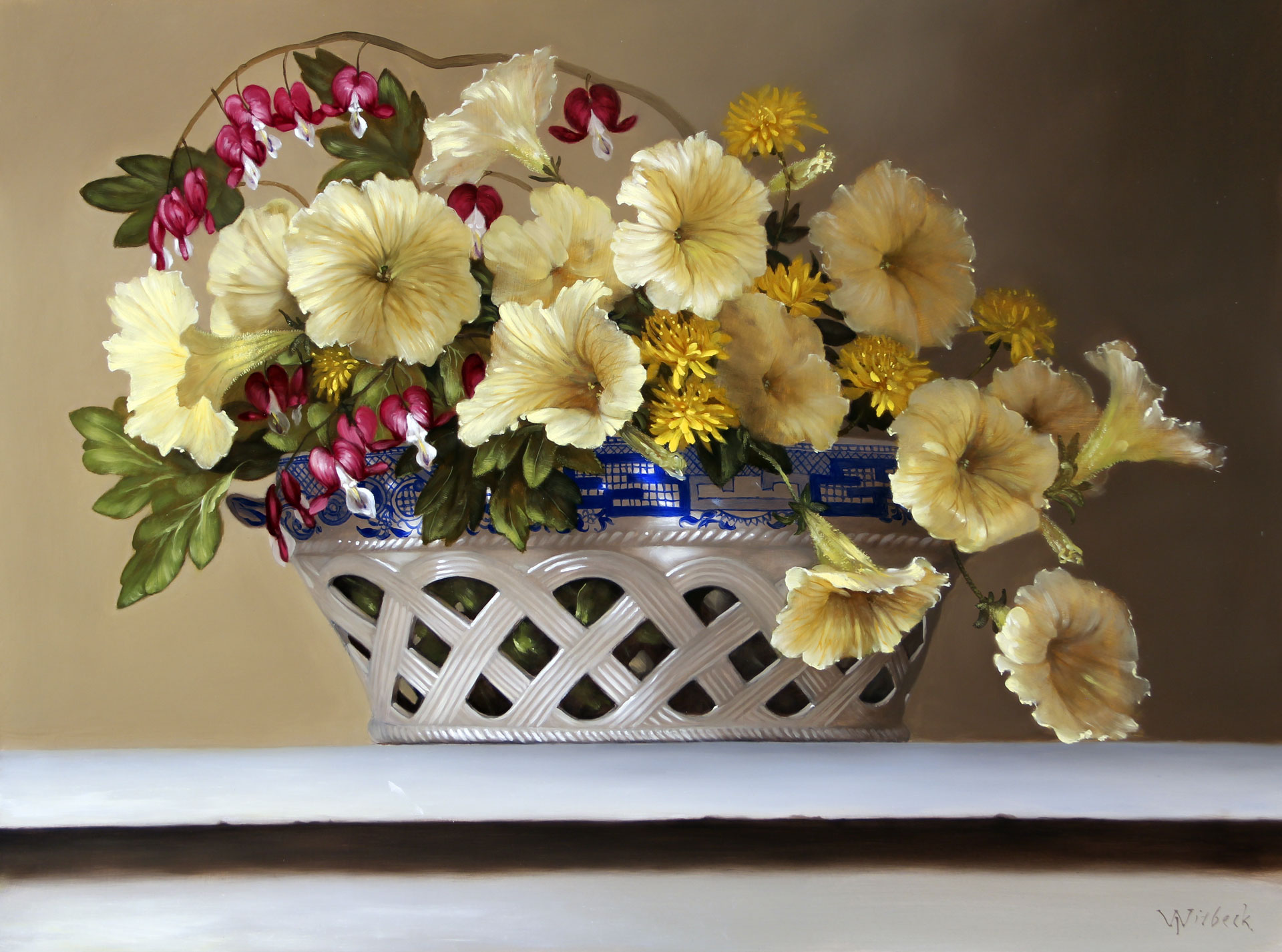Whitbeck Notes
Fall 2020
Fortune Teller
18" x 24" oil on panel
Welcome to the Fall 2020 Whitbeck Notes. In these notes you will be reading the second instalment in a three part series on the route of the valuable Lapis Lazuli stone from Afghanistan to the Netherlands. The first, which can be found in the Spring 2020 Whitbeck Notes, was all about the mining of the stone out of the mountains and its transportation to the Mediterranean coast. Here we will read about its journey across the sea and up into the Adriatic to Venice, with all the various happenings that can accure on such a boat trip, with the final instalment being the overland journey up and over to the Dutch Republic. If nothing more, my hope is that this little story will give you a glimpse into the world of the 17th century and a better picture of the sheer magnitude of what it took to acquire even some of the simplest things. Something these days that is pretty foreign to us. No next day delivery from Amazon for them! I hope you enjoy.
___________________________________________________________________________
Made by human hands, not natural to the ocean, not natural to the water, not made to live in the waves and beaten by many pounds of water, our precious blue stone, now in the hull of a ship makes its way across the dark, deep vastness of the Mediterranean. Each piece of Lapis Lazuli is wrapped in its original burlap and are now carefully packed in square wooden crates, tucked away in the stifling hold, smartly loaded with all the other tons of various cargo so as to spread its weight equally throughout the hull.
Here, in the port of Tripoli, the hands of Venetians, Greeks, Turks and others have loaded this west-bound merchant vessel, packing it with an array of goods ranging from expensive silks to sacks of wood ash destined for the famous glass making workshops of Morano. Besides these there would also be wines, dyes, honey and pepper carried over from Persia as well as fine ceramics and precious jewels from India, all destined for the gondola and galley crowded quay of Venice and the markets of Europe.
The Santa Giustina, our vessel, will also be used for returning ministers, merchants and noblemen back to Italy. For a fee, those in need take advantage of every arrival and departure in these foreign ports. The administrative gears of the mighty Venetian Republic must go on and that involves the movement of these critical officials from one city to another, one port to another or one far flung trading center to another. A Visitatore, the church official whose job it is to inspect the areas under his jurisdiction in the Holy Land will converse and dine aboard ship with ministers who have been working at the Venetian consul in the eastern Mediterranean, as well as with noblemen who will be joining our western-bound ship from places like Cyprus and Crete. Quite the array of passengers.
Despite this being the waning of Venetian influence in the Mediterranean sea with the slow but inevitable switch of control to the Dutch and English, it is still business as usual for the Italians, and the merchants and administrators of that great city on the lagoon relentlessly carry on. The trade goods will sail down the Adriatic from Venice and through the Ionian, then out into the Mediterranean heading eastward towards Syria and Palestine. There, unloaded and sold, the ship will then be repacked with goods destined for the ports of Europe and head back out into the sea to sail home, and after some maintenance and repair, will do it all over again.
These entrepreneurs gamble and risk everything. Their little wooden vessels are pushed about by the wind, and they endure much on these four to six week long voyages. As one 15th century German Monk exasperatingly put it, "People without experience say that the voyage from Venice to Jaffa is a promenade. Oh, heavens! What melancholy amusement, what a wearisome promenade. With how many miseries is it not strewn!" The many sunken ships, broken to pieces at the bottom of the sea-lanes bear silent witness to the truth of brother Felix's words.
As was the case with the caravans that travelled here to Tripoli from the mountainous regions of northwest Afghanistan, so it is too with this leg of our journey, in that it is best to travel in a group, safety in numbers. Besides our Venetian merchant ship, Santa Giustina, there is another called the Biasio Marins, as well as four warships and another two merchant vessels from England. With all ships loaded and ready to depart, and with a fair wind, all set sail heading out of port with the first destination being the island of Cyprus, one of the first stepping stones along the route. Having the wind in our favor the captain of the vessel decided to set the main-course, fore-course and the spritsail, gathering every bit of wind and taking advantage of every inch of canvas. With the crew climbing up the rigging and unfurling the sails and others below to work the lines, our small flotilla was quickly underway.
Experiencing becalmings, good winds and strong winds (one of those strong winds giving a good tear in our fore-course) we had sight of Cyprus in two days. At one point we needed to shorten some of our sails to slow our speed to wait for the English vessels to catch up. Having also lost sight of the Biasio Marins, we were relieved to finaly catch sight of her as we reached the beach of Larnica, in Cyprus. In Saline, the name of the port here in Larnaca, well known for its large, natural deposits of salt, we loaded on fresh water and provisions as well as bringing on the returning Venetian consul whose term had been up and was waiting for a return vessel home.
Dallah with Coffee Beans
14" x 18" oil on panel
Despite the excessive heat of the island many on board would be taking advantage of the few days anchored to walk through the citadel. One would for sure enjoy the kahvehane, the Turkish coffee house, which was quite popular throughout the east despite occasional fierce religious and official opposition to the beverage. Also, you would pass along the stone warehouses and the great customs house of the Aga, who is the chief military officer of the city. Besides these one would also see the well built clay houses of the Turks and Greeks and the magnificent Mosques and ancient Greek churches. The Venetian, English and French consuls were also near by. Such a mixture in this land! Cyprus is ruled by Turkey, but most of the officials here are Greek, and the language that is spoken by the majority is also Greek. This place had also been previously ruled by Venice, and one can see as they make their way through the harbor traces of venetian architecture, especially the great winged lion of Saint Mark, which is the symbole of their power, with all the heads having been decapitated by the Turks upon their victory of the area. Venice once ruled over many of the lands around the Mediterranean, but now, as the 17th century churns on, they find themselves losing their foothold and having to forfeit various trade stations and fortresses along the coasts. New trade routes are changing the whole field of the east-west trade. But business is business, and the coins must flow, so even though they do not have a military hold on many of the areas they trade in, they do still have a strong influence over official goings on. Everyone wants to prosper, and in whatever way this needs to unfold both sides are willing to overlook some strong differences to make this happen.
On the morning of the fifth day in Cyprus, with a favorable east wind, the small flotilla continued westward. In the evening sails were once again lowered and our ship slowed to wait up for some of the lagging vessels. The following day, sailing along we catch sight of one of the Venetian warships that had been escorting us from Tripoli. It has in tow a captured Berber ship that had been carrying lumber. Most likely this ship had come from a port in North Africa. The lumber will now be destined for the busy shipyards in Venice and will be used for the building of new vessels. But the fortunes of the sea go both ways and are not always favorable to European merchants and the crews of their ships. Barbary pirates cruising through the Mediterranean prey on the more vulnerable, taking the vessel itself, the valuable cargo within as well as the crew and passengers who will then be ransomed for as much as they are worth, or as much as their family and friends are willing to pay for them. Of course there are those more unfortunate who do not have that luxury and end up being sold into slavery at the bazaars of Aleppo and other cities and towns throughout the near and middle east. From the journal of one of our wealthy young traveling nobles comes this brief description; "I went to see the caravanserai where slaves are sold, which is made in the shape of a fortress, all of stone. In the middle of it is a very beautiful fountain, and it is enclosed on all sides by arches like a cloister, with the same arrangement on the upper level, which is covered with an iron roof. Here men and women are sold into slavery. Most of them are Georgians, Russians, Pols, and Moors. Those who want to buy go to look at them." And likewise, western Europe was also well versed by this time in the sale of human beings, and a ship taken by them that was full of sailors, merchants and nobles all equaled money in the coffers.
Orange and Silver
36" x 36" oil on canvas
With the English ships catching up cannon salutes were fired; three shots from each of the English with the Santa Giustina answering with one. As our captain, Nocolo Armeni, is "Captain of the Ships", this was custom for the other ships to salute us so. En masse all headed west. The journey from Cyprus to Zante (Zakenthos) which is an island that lies off the western coast of the Peloponnese took longer then expected, with a few setbacks here and there.
Not far into this leg of the journey we were set upon with a mixture of frustrations beginning with a becalming. Two days with this situation was happily turned into a festive occasion. It falling on a holiday, masked dances were held and a feast too, well, as much of a feast as one can have on a rationed ship bobbing around on a calm Mediterranean sea. Throughout the next few days we were hit with contrary winds and rain and fierce wind storms that made control of the ship very difficult. At one point, having spent these days battling the sea our water supply began to run low, and so decided to return to Cyprus and refill the barrels at the port of Baffo. But, once again, strong winds prevented us from entering the port. Taking advantage of this wind and issuing a strict rationing of water, our captain headed back in the direction of Zante with all due course. A mixture of frustrations indeed! This was our eighth day from Cyprus.
Becalmed again, our flotilla was left helpless, drifting about. With a little fortune though a good wind returned and we made headway in a westerly direction. Having caught sight of land on the thirteenth day out our captain and officers thought that we had come upon the island of Rhodes, but on closer look and with the use of our maps coastal illustrations they were able to finally see that we were actually coming up to the great island of Crete, of Labyrinth fame. The eastern end of the island has the favorable port and castle of Paliocastro which is safe and convenient for the loading of water, which we were in the desperate need of. Previous to our landing a guard had to be set to watch over what little water was left.
Upon entering the port, all the ships already anchored there had all gone to arms thinking that we were pirates. One can picture, it being dark and by the light of the moon only, we could easily have been mistaken for the enemy coming in at night. And the warning bells rung to ready for action. Five corsairs, two French ships, three Maltese and one Venetian vessel made quite a scene readying cannon and musket. Also, we were told after disembarking that during the rough weather that we had just come through many ships had been lost and others were taken by Barbary pirates, five of these enemy ships had been sighted in our area. So we had been lucky in that we had made it thus far and that the merchandise in our holds, including the burlap wrapped blue stones might finally reach its destination of Venice, still days and unforetold adventures away.
Crete, the Kingdom of Candia, is still partially in the hands of the Venetian Republic with a few fortresses, which are situated on rocky peninsulas, still holding out against the Ottoman Empire. The Pashas and their soldiers year after year harrow these well fortified rocks, and the Venetians, year after year repel them. But the inevitable fall of these last beacons of venetian power are soon to come and Crete will then be in full control of the Turkish Empire.
Paliocastro, where we had landed, has as its main coastal feature the imposing Greek monastery of Madonna of Acrotiriagnis (Calogeri). It houses forty religious and laypersons who support themselves with some herds and working the lands around the convent. The monks there are also obliged to send word to the larger Turkish administrative town of Sittia, twenty miles to the west whenever a sail is sighted off shore. If enemy sail is sighted then ships are readied and one hundred or more Turks come riding over on horse, but because we were eventually found to be of venetian origin only four came, prepared to collect their taxes from whatever goods the monks would sell to us.
Floral Basket
16" x 20" oil on panel
Continuing on along the north coast of Crete the ships arrived next day near the western end of the island at the fortress of Suda. In the mouth of this bay the fortress protects one side while the castle of Itzeddin, using its Ottoman name, protects the other, making entry difficult for pirates. I should say used to protect, as Suda is still under Venetian control, Itzeddin, however, had fallen to the Turks back in 1645. As mentioned earlier, the Venetian Republic still has a foothold here, albeit a very precarious one.
In port we found the Biasio Marins already arrived and casks of oil destined for the west being loaded into its hold. The port was alive with the activity of other ships from various nations. Venetian vessels coming from and heading to Venice salute us as we come in and we answer with the appropriate volley.
As most of the crew are from this part of Crete, the captain gives permission for them to go ashore and visit family. The captains, officers and nobles are also entertained, with the officers of the the fortress putting on various plays and feasts for them. As the time of Carnival had just passed, all their lines were still remembered and fresh, and props and costumes were still ready at hand. And, too be sure, an extension of the festivities was not an unwelcome thing!
But amidst all of the reunions and revelry, in the middle of the night, there came up such a terrific storm that threatened to wipe out all of the ships in the harbor. What made this worse was that most crew and officers were on shore with only a skeleton crew on hand to maintain the ships in this potentially disastrous event. But the storm weakened, and as the nephew of one of the nobles on shore had put it, "However it pleased God that the storm should die down after midnight without having done great damage." This could have been the end of our precious cargo and the beautiful potential of our blue rocks. Having travelled so far with so many trials and tribulations, it could have ended here, at the bottom of Suda Bay eventually covered over with sand and stone, once again being returned to the land. But it was not to be, and next day, with the help of oars during a calm, our ships were rowed out of the bay accompanied by the customary salutes from the fortress, and so the journey continued.
Leaving Crete we now keep to a northwest direction heading for Zante. Off of the southern coast of the Peloponnese the wind grew contrary and we had to drop anchor. In hindsight this ended up being a blessing. Upon eventually entering the port of Zante we received news that just a few days earlier five Barbary pirate ships had been spotted departing from Navarino, not far away, and that if our course had continued on as normal we most likely would have crossed paths at some point which would have meant evasive actions or full out battle. Fortunately for us we had to do neither.
In the port of Zante we once again saw many ships with a number of these being from England and France. One of ours, the Saint Antonio, a tender, was heading off to Syria while another, the Irede was on its way to Izmir. Also, having been reunited with two of our English companions, we had learned from them that after one of our bad storms in which many of us had been separated, they had run into some enemy ships, but due to the oncoming darkness they were able to slip away and evade a confrontation. What a precarious world this Mediterranean is! Between the ambitions of man and the whims of the sea one never knows what is in store from one day to the next!
The rest of the journey was relatively uneventful besides the one sail we spotted in the Strait of Cefalonia, between Kefallinha and Ithaca. To the relief of everyone it turned out to be Venetian, and with a few salutes from them to our Captain of Ships, which is the custom, we each made our seperate ways.
On the morning of the 14th we came upon Ossero, which lies further up on the Dalmation coast along the Adriatic. By afternoon we spotted the two towers of Rovigno and Parenzo, and by sunset of that same day we were at the Gulf of Triest. And from the words of one passenger aboard, "Finally, to my unspeakable relief, at dawn on the 15th I saw the campanile of San Marco and my dear homeland, Venice." From here the ships passed into the Lazaretto Vecchio where all returning vessels from foreign shores must land, and all passengers, from servants up to the most privileged of noblemen must quarantine for twenty two days. The fear of spreading disease being of great concern here, and every precaution capable being taken.
Dallah with Clementine
10" x 10" oil on panel
It seems that Ultra Marine is an appropriate name for the paint made from Lapis Lazuli, as its translation becomes beyond the sea. And as this brief description of our little flotillas approximate eight week journey shows, it was quite an ordeal and had the possibility of being even more so. Between hidden pirates, disastrous storms and unforgiving disease it seems a good chance that a merchant ship might not even make it from Venice to Tripoli. As the German monk Felix had put it, "With how many miseries is it not strewn!" Much was earned from the Lapis and the risks and expenses were worth it so many merchants thought. And they went through the trouble to procure these stones, dug out of the rugged mountain sides and deliver them back to Italian shores and into the broader area of western Europe.
Now, after all of the merchandise had been sent through the customs house and then taken off by the appropriate owners, our Lapis Lazuli would now be readied for its final overland trip, up into the Dutch Republic to the apothecary who will then sell it to the artist for his studio. Having been through so much, one would now see this stones beauty painted into the vibrant blues of a Madonnas robe, the blue silk of a rich mans hunting bandolier or the expensive jacket of one of Gabriel Metsus elegant women, or even the turban worn by one of Vermeers daughters in the famous Girl with the Pearl Earring. There is a life and story to everything, even what would be considered the simplest of things, and so in the next Whitbeck Notes our "simple thing" will finish its final leg of the journey and its grand adventure will finally come to an end.
___________________________________________________________
Many of the details put into this Whitbeck Notes were taken from two great books, both of which I highly recommend. The first is called Rare Adventures and Painful Peregrinations by William Lithgow. Lithgow was a Scottish adventurer who travelled all through out Europe and the Near East in the 1630s, who even survived torture by the Spanish Inquisition! This is a unique travel log done from the perspective of a 17th century European. The second book, and the one in which most of my information came from is The Travels and Journal of Ambrosio Bembo. I used this one mostly because it fit exactly the period and travel routes that I needed: Venetian merchants going from Venice to Syria and all of the ordeals that could happen in between. Bembo was a young Venetian nobleman who decided to travel east, all the way to India and back beginning in 1671. Upon his return home he turned his journal into a book, including illustrations done on the spot by a travelling companion and saved for the world his precious observations form everyday happenings to elaborate court ceremonies. He opens up the world of the 17th century middle east and the life on and around the Mediterranean. His words were a perfect vehicle to send our Lapis Lazuli sailing along on its way to the Lagoons of Venice.
Tooth of the Lion
18" x 24" oil on panel
Please be sure to take a look at my website www.jameswhitbeck.com to view the latest painting or to read previous Whitbeck Notes. And, if shows do start up again, you will be able to find a show schedule under Art Shows. Feel free to write or call with any questions on the paintings.
All my best,
and stay safe,
James Whitbeck
(413) 695-3937
